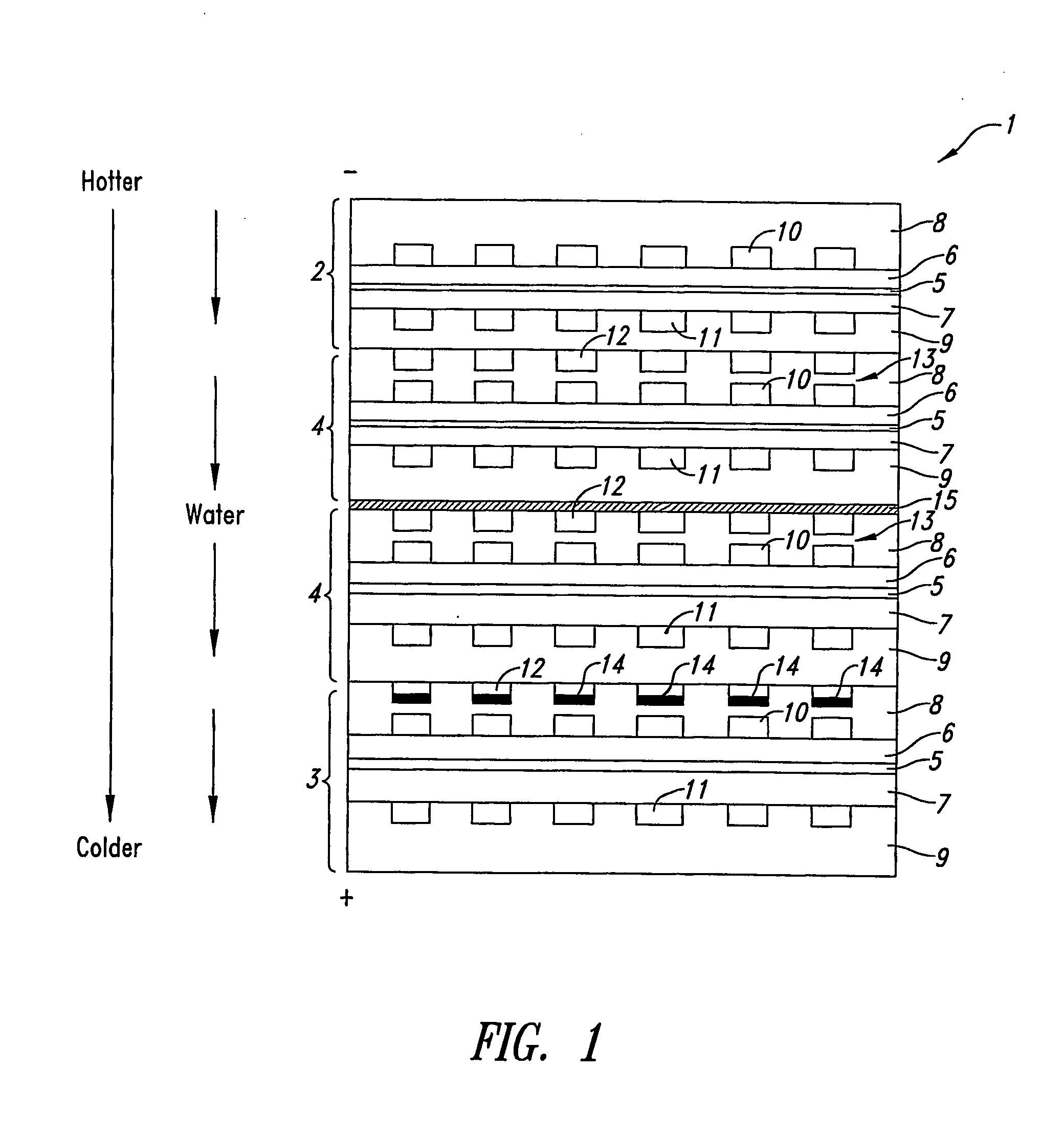Shutdown Methods and Designs for Fuel Cell Stacks
- Summary
- Abstract
- Description
- Claims
- Application Information
AI Technical Summary
Benefits of technology
Problems solved by technology
Method used
Image
Examples
example 1
[0035] Two high aspect ratio SPE fuel cells were made in which the MEAs comprised NAFION® N112 perfluorosulfonic acid membrane electrolyte with carbon supported Pt / Ru catalyst applied on one face and carbon supported Pt catalyst on the other face to serve as anode and cathode electrodes respectively. The MEAs also comprised polytetrafluoroethylene (PTFE) impregnated carbon fibre paper substrates to serve as gas diffusion layers on each side of the catalyst coated membrane electrolyte. Grafoil® graphite reactant flow field plates with linear flow channels formed therein were located on either side of the MEAs, thereby completing the fuel cell assembly.
[0036] For testing purposes, independently controllable electrically heated bus plates were placed on each side and the cells were initially operated on hydrogen and air reactants at 70° C. Then the flow resistance of the hydrogen fuel in the anode flow field plate was measured as a function of temperature difference across the cells T...
example 2
[0038] A fuel cell assembly similar to those of Example 1 was prepared in which about 6 g of water was applied to the cathode flow field plate but the anode side was dry. The membrane electrolyte contained about 5% absorbed water by weight (equilibrium level at room temperature and humidity conditions). The wet cathode side of the cell assembly was then placed on a hot plate set at 70° C. and the anode side insulated such that the anode flow field plate was about 2° C. colder than the cathode flow field plate. In this arrangement, water transfers from the cathode side to the anode side of the cell and accumulates at the anode plate. The rate of water transfer from the cathode to the anode side was then determined via weight gain measurements of the anode plate. (The cell was removed and allowed to cool for about 30 seconds before each weight measurement of the anode plate). The test was repeated without using insulation on the anode side such that now the anode flow field plate was ...
example 3
[0043] A fuel cell assembly similar to that of Example 1 was prepared with two circular pieces cut out of the MEA. The MEA was wetted and the weight of the gas diffusion layers and the catalyst coated membrane in these cutout pieces was determined. The weights of a wetted anode flow field plate and a dry cathode flow field plate were also determined and a fuel cell assembly was prepared by placing the MEA (including the cutout circular pieces) between the plates. A temperature difference of about 2-3° C. was applied across the fuel cell assembly (with anode hotter) for about 20 minutes at 60° C. using the heating apparatus of Example 1. Thereafter, the fuel cell assembly was disassembled and the weights of the various components measured again. The weight of water in each component before and after exposure to the temperature difference was then calculated by subtracting the known dry weight of each component. The results appear in Table 2.
TABLE 2CathodeCathode gasCatalystAnode ga...
PUM
 Login to View More
Login to View More Abstract
Description
Claims
Application Information
 Login to View More
Login to View More - R&D
- Intellectual Property
- Life Sciences
- Materials
- Tech Scout
- Unparalleled Data Quality
- Higher Quality Content
- 60% Fewer Hallucinations
Browse by: Latest US Patents, China's latest patents, Technical Efficacy Thesaurus, Application Domain, Technology Topic, Popular Technical Reports.
© 2025 PatSnap. All rights reserved.Legal|Privacy policy|Modern Slavery Act Transparency Statement|Sitemap|About US| Contact US: help@patsnap.com



